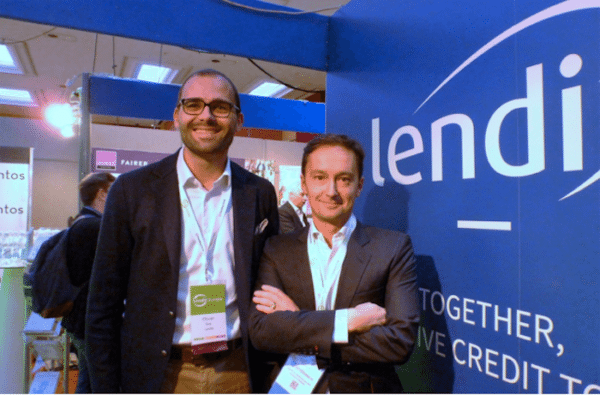European SME lender October began by building a product for internal use, but the industry needed it too, so they branched out, COO Patrick de Nonneville said.
October was founded in 2015 after de Nonneville had been looking at some Fintech investments in Europe. It was around the time LendingClub and Funding Circle were gaining traction, so there was a clear desire in the marketplace for more.
The Origins of the Technology
 Through his experience vetting fintechs de Nonneville observed that many venture capital funds might know technology but not finance. Around this time he met eventual co-founder Olivier Goy and after talking for an hour they decided to create a company that is adept at both funding and technology. October made its first loans in 2015 and now operates in France, Germany, the Netherlands, Spain, and Italy.
Through his experience vetting fintechs de Nonneville observed that many venture capital funds might know technology but not finance. Around this time he met eventual co-founder Olivier Goy and after talking for an hour they decided to create a company that is adept at both funding and technology. October made its first loans in 2015 and now operates in France, Germany, the Netherlands, Spain, and Italy.
“What we do is make SME lending faster, easier, cheaper and safer,” he began.
Europe’s SMEs have had a hard time during the pandemic, de Nonneville said. More than 23 million companies employ more than 90 million people and are vital to the region’s economic health. To date, October has provided €650 million in financing to SMEs in five countries. They began by lending, making their mistakes, and learning lessons from everyone, de Nonneville said. Along the way, they built tools to fix the problems they were having with fraud, processing speed, and data extraction.
“Frankly we had no intention of selling that to anybody,” he admitted.
October began seeing the success of some pure tech players, looked at their own product, which was specifically built for the European market, and reasoned that if people were interested in using it there is a strong business case to offer their services to the marketplace. Even though that decision was only made a few months ago, they have five customers lined up, with announcements coming in the weeks ahead.
“We think it’s better to feed your innovation from what you have done yourself as well,” de Nonneville said. “It makes you a lot more relevant to your customers.”
The process of working with those customers is simple, de Nonneville said. October develops a proof of concept and analyzes deals the client had already decided to finance.
“We’ve been able to show demonstrably that a big portion of loans that goes all the way to committee at those banks should have been stopped day one, automatically,” de Nonneville said.
Growing the Company During the Pandemic
He admitted growing a company during the pandemic was challenging. Last spring October’s leadership feared a significant portion of their portfolio would default. They also wondered if investors would be hesitant to fund new loans. And with state-guaranteed money flowing through banks, there were concerns customers would migrate there.
The team got to work in their five countries while also refining their technology (“it forced us to accelerate everything we do,” de Nonneville explained). Their approval process speed on 60 per cent of their loans went from two days to instantly and that attracted business. October’s portfolio behaved well, as the stimulus money caused default rates to fall. In that environment, October raised more money in 2020-21 than ever before, with two-thirds of it coming since the summer of 2020.
New initiatives are on the way, too. October is developing lending products, including an embedded feature that allows banks to offer instant loans to customers of up to €30,000 using the data already in their account. Those loans will also come with interest rates of around seven per cent.
“It’s a sign of the kind of trust we have built in our own models to be just able to take the transaction data and give an instant answer to our customers,” de Nonneville said.
Working With Different Customer Needs
Customers can integrate October technology in different ways. They can replace their previous stack with the complete October system. Others opt to use certain components via an API.
“It’s powerful when you demonstrate it works because it works for you,” de Nonneville said. “You stop a few frauds and it pays for itself.”
 Those early experiences were pivotal in shaping the quality of October’s technology, de Nonneville said. At the beginning they looked at some fraud cases to see what lessons they could glean from them. As the number of applications grew, the data extraction models became smarter, and that learning continues.
Those early experiences were pivotal in shaping the quality of October’s technology, de Nonneville said. At the beginning they looked at some fraud cases to see what lessons they could glean from them. As the number of applications grew, the data extraction models became smarter, and that learning continues.
Another key early decision was to demonstrate how October’s technology worked in an explainable fashion, de Nonneville said. That counters the trend of keeping your secrets in a black box, and goes back to the early lessons of wanting to learn from your mistakes.
“You owe it to your customers, and you owe it to your teams, transparency on why your model is making a decision and we’ve become really good at doing that,” de Nonneville said, adding October has reduced defaults by more than 90 per cent since 2018.
Technology Can Still Improve the Product
As the amount of data grows, machine learning models improve, and that provides opportunities for targeted cross-selling, de Nonneville said. Technology can also help improve the transparency for SMEs by making it easier to report on portfolio stability to their stakeholders.
“Few do that well for small companies,” de Nonneville said. “We actually think we can do that.”
Many companies speak about wanting to improve their data extraction technology, but few have talked with as specific of a focus as de Nonneville does. The more documents in the more formats you capture, the harder it is to develop systems that account for those variances. Better to know what you are looking for before you begin so you focus the technology on producing the data you need the most.
“On the things we think are important to make that decision, it works very well,” de Nonneville said. “That’s the advantage – we know what we are looking for. It is easy to look for the needle in the haystack if you know what the needle looks like.”
During the pandemic October introduced a tourism loan that de Nonneville said was a direct response to the challenges that industry faced. Both sides wanted it – the SMEs needed the help while investors were looking for products that could generate returns while also helping the sector. While many were concerned about adding risk at the beginning, the option has proved successful.
“The crisis for us in the end has been a great opportunity to launch new products, demonstrate the model is resilient and grow our company in a way that was probably not predictable,” de Nonneville said. “We’re trying to make the best of what has been a really tough situation for all of us.”
Coming Rules to Benefit European SMEs
October is looking forward to future regulations which will allow investors anywhere in the European Union invest in SMEs anywhere else in the union, de Nonneville said. That will allow retail investors to access many new markets while providing new funding sources for businesses clearly in need of them.
It also is consistent with October’s mission to provide more equitable funding and investment opportunities to SMEs and all investors.
“It is encouraging when you see people from another country want to support companies in others,” de Nonneville concluded.


